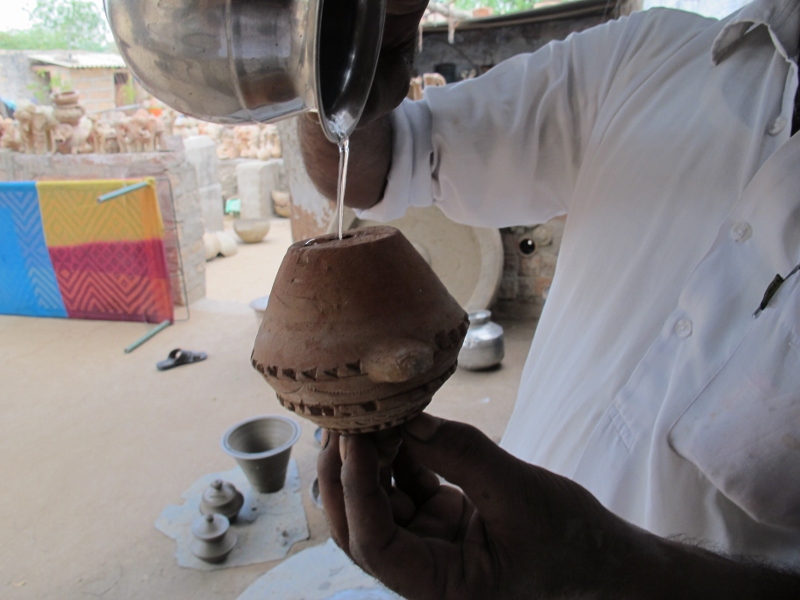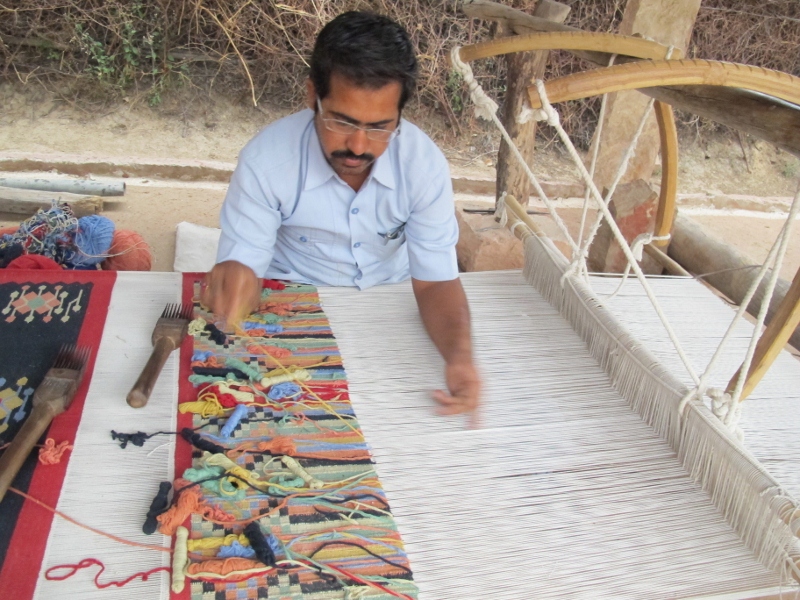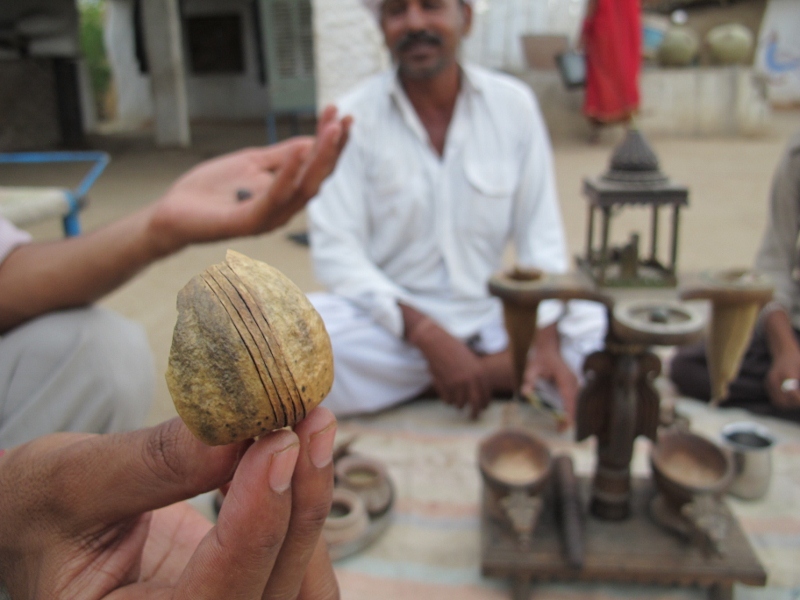The first day of my road trip through Northern India began with a journey to the blue city of Jodhpur.
My first stop was the village of Salawas, where I met with a family of potters. In this village, the art of pottery, from the shaping of each piece, to firing up the kiln, and eventually glazing each item, has been passed down for generations, and each family's subsequent children are expected to continue the tradition. Outsiders are welcome to admire the process, but are generally not invited to train in this craft. It is considered a proud lineage, and these craftsmen are expected to not only continue on with this skill, but to also marry only within their caste.

As the leader of the family took his well-worn seat behind the stone wheel, I waited in anticipation. Having taken a few pottery classes myself, I was familiar with the loud hum of the machine operated pottery wheels. Looking around at the dirt floor and the wandering chickens and goats, I wondered how this family would manage to create enough quality product to support themselves in such a rustic setting.
The moment the potter began his process; all my inner judgments and questions were silenced, and replaced by a quiet awe. He selected what looked to me as an arbitrary amount of clay and began pounding it into a cube to remove any air bubbles. Then, he prepared the stone wheel by poking a wooden stick through a drilled hole and manually spinning the wheel faster and faster, until it spun on its own. In a matter of seconds, the potter had the clay cube on the wheel and was molding the top of the mound into a perfectly shaped dish. Repeating this series two other times, it became evident that the exact amount of clay he had chosen, was the perfect size for three individual items.
After watching this process in amazement, I took some time to walk around the family compound and admire the display section where the potter's work was showcased. While the family spends the bulk of its time creating large white pots used to hold water and keep it cool during the hot summer days, they also create a variety of pots and containers. Typically the men are trained in pottery, while the women are responsible for mixing colors and painting the pieces. After gazing through the pile of spice containers, candleholders, and painted tiles, we were shown the piece de resistance of the collection: the genie lamp.

The potter held up a tiny lamp and poured in a handful of water. He then turned the lamp upside down, had me place my hand over it three times, and repeat an incantation after him. He then up righted the lamp and poured it over the parched ground, but no water came out! Turning the lamp upside down once more, he had me repeat the hand waves and chanting, and then poured the lamp over the ground. This time, all of the water spilled out of the container and was thirstily swallowed up.
I waved goodbye to the potter and his family from the back of my jeep, and left with a hope to visit them again, and perhaps one day be granted a rare lesson or two.
As the jeep chugged along the bumpy dirt roads, Raghu explained that Jodhpur had once been a stop on the legendary Silk Route, and was now known throughout India as a key force in the weaving and textile industries. We were now on our way to visit a family that was part of a government funded weaving cooperative, and would get to observe the rare process of ambidextrous weaving.

Still in the village of Salawas, we came to the home of the Parjapaji Brothers, experts in the craft of weaving, or more specifically creating rugs known as durries. I observed the complicated ambidextrous weaving process, and saw how it produced the exact same pattern on both sides of each carpet. The process involves an interlocking of threads instead of knots and uses a variety of camel and goat hair, silk, and cotton. One carpet can take two people over three weeks to create, working 8-10 hours a day.
Suddenly, the rain began to fall, a rarity in this desert climate. Instead of feeling frustrated at having to quickly cover their prized creations, the weavers offered up a prayer of thanks. They turned to me and explained that visitors in their village were quite rare and rain in the summer season rarer still. The combination of my presence and the rain were an unexpected double blessing and they thanked me repeatedly for coming.
Blinking back tears at the emotional and kind welcome of these strangers, I stepped out into the refreshing rain and back onto my jeep. I had one more stop to make before I left the outback and entered the actual city limits of Jodhpur.

During my six-hour drive from Udaipur to Jodhpur, my driver had previously explained the meaning behind the colors of the turbans worn by the village men. As my jeep rattled onto the dirt road to Mogra, the Bishnoi village where we would meet with our last local family, I grew excited at the prospect of seeing these turbans up close.
After accepting some delicious home brewed chai tea, my host showed me his multi-colored turban, and gave me a lesson on how to properly wrap one.
He then performed a traditional opium ceremony, where the nut from the poppy seed is ground up into a fine liquid and used as both a gift for the gods and as a relief from the hard work in the fields. The Bishnoi elder looked pretty relaxed after he drained the contents of the opium dish. Much to my disappointment, we were not offered to join him.
As the light faded into the pale oranges of a desert sunset, I hopped onto my jeep for the final drive to my hotel. The day had been a nonstop ride through the different castes and traditions of the Jodhpur outback and I looked at my hands with newfound respect wondering what they might be capable of creating.
I made it my new mission to find out.